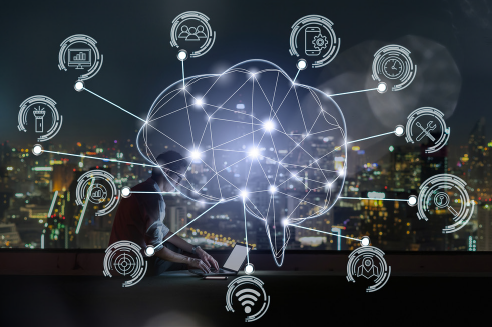
Data engineering is changing. Thanks to exponential growth in data volume, the diversification of data sources, and the need for real-time analytics, complexities are intensifying — often outpacing the capabilities of traditional methods and leaving data engineers striving to keep up.
A technological breakthrough has emerged to streamline and revolutionize data engineering: Generative Artificial Intelligence (GenAI). It’s making waves in the news and dominating Forrester’s Top Ten Emerging Technologies. This groundbreaking technology promises to simplify data pipeline development, enhance efficiency, and transform how organizations harness their data.
The question isn’t just how GenAI will disrupt traditional data engineering paradigms, but also how the role of data engineering will change to support the usage of GenAI in companies.
If you’ve ever questioned the future trajectory of data engineering, or pondered the technical leaps we’ve made between manually setting up cron jobs from a bash-terminal to AI-driven automation, this whitepaper is for you. Dive in to unravel the transformative power of GenAI and chart the course for the next generation of data engineering.
Chapter 1: Concepts in Generative AI
Generative AI is a subset of artificial intelligence that focuses on creating new, previously unseen responses to queries based on patterns learned from existing data.
Before we dive deep into the intricacies of how generative AI intertwines with data engineering, it’s imperative to understand its foundational elements. We’ll look at the various types of generative AI models and key concepts. We’ll also take a closer look at the underlying machinery, namely neural networks and deep learning.
The evolution of deep generative models
Historically, generative models were statistical tools mainly focused on numerical data analysis. However, the advent of deep learning thrust them into a broader spectrum, encompassing images, voice, and text.

Variational Autoencoders (VAEs)
VAEs marked a significant transition in the generative model timeline. Beyond their core function of encoding raw data into a condensed form and decoding it, they introduced a novel feature: spawning variations from the foundational data.
Generative Adversarial Networks (GANs)
GANs, conceptualized by Ian Goodfellow in 2014, are a paradigm shift in generative AI. Pitting two neural entities—the generator and the discriminator—against each other, GANs have facilitated the creation of synthetic data that is virtually indistinguishable from real data. Their utility has been realized in sectors from entertainment to medicine, showcasing their adaptability and potential.
Transformers
Unveiled by Google in 2017, Transformers amalgamated the encoder-decoder mechanism of VAEs with an ‘attention’ module, revolutionizing language model frameworks. This architecture fostered a deeper, more nuanced understanding of language structures and relationships without explicit grammar-based training.
Must know concepts in Generative AI
It’s crucial to grasp several fundamental concepts to navigate GenAI effectively.
Latent space: The creative canvas
The latent space is an abstract, lower-dimensional representation of the training data. It captures its essential features and patterns. Within this latent space, generative models are able to explore and manipulate data in novel ways. They can produce new data points similar to the original data but still distinct. This “creative freedom” models have within the latent space is what allows generative AI to produce diverse and imaginative outputs.
Training data: The foundation
High-quality training data is a bedrock upon which AI models are built. The performance and capabilities of generative models are inextricably tied to the training data they’re exposed to. This is comprehensive, diverse data representative of the task or domain the model is intended for.
The quality and quantity of training data profoundly impact a model’s ability to understand the underlying patterns and nuances of data it generates. Generative models may struggle to produce realistic, meaningful outputs without sufficient quality and quantity of training data. In other words, these models will struggle to solve novel engineering problems that don’t already possess a large corpus of potential solutions in the training set. GenerativeAI is good at providing answers that are similar to well-solved problems. It’s effectiveness drops quickly when traversing into completely new subjects and techniques.
Neural Networks and Deep Learning: The Engine of Creativity
Generative AI operates at the intersection of creativity and technology, and at its core lies the powerful machinery of neural networks and deep learning. Neural networks are computational models inspired by the human brain, consisting of interconnected nodes, or neurons, organized into layers.
In generative AI, neural networks play a pivotal role in both encoding and decoding
data. They serve as the engine of creativity, enabling the transformation of abstract representations in the latent space into concrete, meaningful outputs.
Vector-Databases
Generative AI functions by not simply knowing about individual data points but also the relationship between them. It needs to know the similarity of concepts and symbols in order to provide reasonably accurate responses to queries. These models achieve this by encoding structured and unstructured data into tokens, and then mapping tokens into vectors as part of the training process. These mappings are stored in a vector database that can encode significant features. For example, that ‘cat’ is closer in relevancy to ‘dog’ than it is to ‘ocean.’
Use Cases and Innovations in Generative AI
Understanding the practical applications and innovations this technology brings to various industries is vital. Generative AI is not just a theoretical concept; it’s a transformative force that accelerates innovation and augments how we work and create. Gartner has identified five use cases that demonstrate the range of generative AI:
- Drug Design: Generative AI expedites drug design, potentially reducing costs and timelines in the pharmaceutical industry. It explores diverse design possibilities, accelerating drug discovery.
- Material Science: Across sectors like automotive, aerospace, and energy, generative AI advances material science. It tailors materials with specific properties, pushing boundaries and meeting evolving demands.
- Chip Design: Generative AI transforms semiconductor chip design using reinforcement learning. It optimizes component placement, reducing product development time to hours.
- Synthetic Data: Generative AI generates synthetic data, preserving privacy in healthcare and other sectors. It empowers data-driven insights while safeguarding sensitive information.
- Parts: Generative AI is pivotal in optimizing manufacturing and enhancing components for performance, materials, and sustainability.
While these applications highlight the versatility of generative AI, its true potential for data engineers lies in the realm of data pipelines. Generative AI promises a future where these pipelines aren’t just static entities but adaptable, intelligent systems. Let’s dive into it.
Chapter 2: Data Engineering in the Modern Tech Landscape
Data engineering’s core purpose is to provide the infrastructure to harness data for use throughout the organization. This section will delve into the technical aspects of data engineering and how GenAI reshapes the landscape of data engineering.
Defining Data Engineering

At its core, data engineering is the discipline of designing, building, and maintaining data pipelines and models. These assets are the backbone of data-driven organizations, ensuring that data is collected, stored, processed, and accessible to stakeholders.
Data engineers are the architects of these systems to make this happen. They orchestrate the flow of data from diverse sources into purpose-built environments, where it can be analyzed and leveraged by the organization. This process involves extracting data from sources, transforming it into derrivative formats, loading it into data warehouses or lakehouses, and making it available for analysis.
Understanding the biggest challenge: Data pipeline complexity
Data pipelines present several complex challenges that data engineers must adeptly manage.
- Scalability Challenges: To tackle scalability challenges effectively, data engineers must design pipelines capable of both vertical and horizontal scaling. This entails selecting appropriate technologies, such as distributed computing frameworks and cloud-based solutions, to scale out and handle a growing variety of data loads seamlessly. Furthermore, implementing clustering, fault tolerance, quality testing, and observability is crucial to building pipelines that autonomously adapt to fluctuating data demands.
- Data Integration and Transformation: Integrating and transforming data into a cohesive, usable format poses a significant challenge. This process involves data cleaning, normalization, and harmonization. Automation through suitable ETL (Extract, Transform, Load) tools and frameworks minimizes manual intervention, reducing the risk of errors. Establishing robust data governance practices ensures data consistency and quality throughout the pipeline.
- Ensuring Data Quality at Scale: Maintaining data quality becomes an intricate task as data pipelines expand. Data engineers should implement data validation checks, anomaly detection systems, and real-time data monitoring mechanisms to identify and rectify quality issues promptly. Furthermore, emphasizing data lineage and documentation is vital.
In the context of these core challenges, generative AI offers a unique solution to building sustainable and autonomous data pipelines.
GenAI’s influence on data engineering
AI and GenAI are assuming central roles in every major organization. Similar to many of their counterparts in other departments, data engineers can benefit greatly from incorporating GenerativeAI into their current workflows. This is the current landscape:
- Data engineers face mounting pressure to build and maintain reliable data pipelines that extract insights from massive volumes of unstructured data. Generative AI can effectively harness unstructured data with proper tokenization and use of paradigms such as retrieval augmented generation (RAG). This allows data engineers to get these unstructured datasets into immediate distribution throughout the organization, bypassing several layers of a traditional semantic search stack.
- Generative AI can transform the process of building and running data pipelines. Code for common SQL transformations can be generated by the engine and either manually QAed by data engineers during construction, or autonomously audited by data quality algorithms that reject inappropriate versions of the code built at runtime. The orchestration of these pipelines can be given over to automation controllers to ensure that any code generated by data engineers is seamlessly orchestrated alongside any generated output.. This allows data engineers to focus on writing code for the most important and novel parts of the data pipeline, while automating the creation and orchestration of standard ETL operations.
- Data engineers can collaborate with business teams to identify use cases to identify areas that are not sufficiently data-driven and then leverage GenerativeAI to rapidly build out supporting pipelines. This is true of both traditional structured data, and also unstructured data which can be exposed via LLMs using RAG. Surfacing this data lays the groundwork for further automation of the business when the SMEs can begin encoding their decision-making flows based on live data. This makes piloting GenerativeAI applications within the business one of data engineering’s most valuable new focus areasOne.
It’s essential to acknowledge the pivotal aspect of the GenAI era. It extends beyond its impact on data engineering; it’s about the transformative role data engineering assumes to facilitate GenAI adoption within companies. Businesses worldwide are awakening to the necessity of feeding Language Model Models (LLMs) their proprietary data in controlled settings, catering to both internal and external consumers. This represents the new horizon of data engineering.
To realize this vision, data engineers must undergo a fundamental shift in their practices. They must now transition away from manual data pipeline definition and operation.
This transformation entails technological evolution and a shift in mindset regarding the strategic priorities within their role. As data engineering continues to evolve within the data lifecycle, AI and GenAI promise to be powerful allies, driving innovation, productivity, and collaboration among data engineers and their organizations.
Chapter 3: Applying Generative AI to Data Pipelines
GenAI offers novel approaches to key aspects of data pipeline development, including documentation, testing, code optimization, and automation.
Documentation
GenAI can automatically generate comprehensive documentation for data pipelines. For instance, consider a data engineering team working on a complex ETL (Extract, Transform, Load) pipeline. GenAI can analyze the pipeline’s structure, data sources, transformations, and dependencies and generate documentation that includes:
- A detailed pipeline flowchart showing data flow from source to destination.
- Descriptions of each transformation step, including the logic and input-output relationships.
- Dependency graphs highlighting which components rely on others.
- Configuration details, such as source and destination connections and credentials.

This documentation aids troubleshooting by providing a clear overview of the pipeline’s workings, and it supports knowledge transfer by allowing new team members to quickly understand the system.
One caveat: be careful in your expectations of Generative AI’s understanding of your internal data models. While it can be reliably expected to explain “what” the data pipeline is doing, it is unclear whether sufficient training data exists for GenAI to explain the “why” behind data pipeline operations. The idiosyncrasies of your internal data remain the territory of data engineering experts in the business, and it is important that thought be put into documenting them in ways that future engineers (and AI models) can consume.
Testing
GenAI can automate testing processes by generating test cases, code, and synthetic data. For example, in a machine learning model pipeline, GenAI can:
- Create a variety of test datasets with different characteristics.
- Generate test scripts that simulate various contrived real-world conditions such as sporadic API operation or significantly late arriving data.
- Monitor the pipeline’s behavior, logging inputs, outputs, and intermediate results.
- Automatically compare the pipeline’s output to expected outcomes.
- Alert data engineers if any anomalies or deviations are detected.
By automating these tasks, GenAI helps data engineers thoroughly test their pipelines, ensuring they perform as expected before deployment. This reduces the risk of errors and issues in production.
Code Optimization
GenAI can analyze and optimize pipeline code for performance and efficiency. For instance, consider a data processing pipeline written in Python:
- GenAI can identify inefficient data transformations and suggest more efficient algorithms or libraries.
- It can flag and optimize code segments that perform redundant operations spanning multiple steps in the pipeline.
- GenAI can provide recommendations for parallelizing or distributing tasks to improve scalability.
- It can suggest memory optimizations to reduce resource consumption.
By automatically identifying and addressing these issues, GenAI helps data engineers write more efficient code, reducing processing times, lowering infrastructure costs, and improving overall pipeline performance.
Pipeline Auto-Assembly and Other Automation
GenAI can automate the creation, configuration, and orchestration of data pipelines. For example, in a streaming data pipeline:
- GenAI can generate code templates based on predefined pipeline specifications.
- It can configure data connectors to various sources and destinations.
- GenAI can interface with automation controllers to orchestrate the execution of pipeline stages and dependencies.
This automation accelerates the development of new pipelines, reducing manual coding efforts, and ensuring adherence to best practices. It also makes it easier to adapt to changing data sources and requirements, as GenAI can quickly adjust the pipeline configuration based on input parameters or evolving data schemas.
Chapter 4: Technical Considerations and Challenges
While GenAI offers transformative capabilities, it also raises critical data privacy, ethics, and performance management issues. Let’s explore these challenges and strategies for addressing them.
Data Privacy and Security
Integrating GenAI into data pipelines introduces the need for safeguarding sensitive information. GenAI models, often trained on vast datasets, have the potential to inadvertently expose sensitive data during generation. Data engineers must implement robust data anonymization and masking techniques to protect confidential information. This includes strategies such as differential privacy, tokenization, and encryption, which mitigate the risk of data leakage.

Additionally, data regulations, such as GDPR and CCPA, impose strict requirements on how organizations handle personal data. When using GenAI in data engineering, ensuring compliance is paramount. Data engineers must implement mechanisms for data consent, tracking, and auditing. Additionally, they should work closely with legal and compliance teams to align GenAI-powered pipelines with regulatory standards and reporting requirements.
Addressing Ethical Dilemmas in AI-Driven Data Engineering
Bias in AI models can perpetuate existing inequalities and lead to unfair outcomes. Data engineers must actively address bias in GenAI models used within data pipelines. This involves scrutinizing training data for biases, implementing bias mitigation techniques, and conducting fairness audits. Ethical considerations should guide the selection and curation of training data to minimize the risk of model outputs that are inadvertently biased toward harmful or inefficient solutions.
Performance Monitoring and Management
The dynamic nature of data engineering demands real-time monitoring of GenAI-powered pipelines. Data engineers should implement comprehensive observability systems that track data flow, model performance, and pipeline health. Anomalies or deviations from expected behavior can be detected early, enabling swift intervention and minimizing disruptions to data processes.
GenAI models require ongoing management to address model drift and ensure continuous improvement. Data engineers should establish feedback loops that collect real-world data and retrain models periodically. Monitoring for model degradation, concept drift, or changing data patterns is essential for maintaining the reliability of GenAI-powered data pipelines.
Navigating Future Considerations in Generative AI and Data Engineering
The fusion of generative artificial intelligence (GenAI) and data engineering has set the stage for a future where data pipelines are not only efficient and reliable but also creative and autonomous. Looking ahead, several pivotal future considerations will shape the landscape of GenAI-powered data engineering.
Advancements in GenAI models will usher in more powerful and versatile capabilities, enabling data engineers to quickly create new pipelines and drive innovation. Ethical AI and bias mitigation will remain a key focus, with ongoing efforts to detect and reduce bias in AI-generated outcomes. Automation will streamline pipeline operation, boosting efficiency and productivity. Enhanced data privacy and security measures will be essential to meet stringent regulations. Real-time performance management and interdisciplinary collaboration will be crucial for maintaining the reliability and resilience of data processes.
In this dynamic landscape, data engineers and organizations must embrace these future considerations, staying at the forefront of GenAI advancements and ethics and harnessing automation to unlock the potential of data-driven decision-making. The future is promising, offering limitless possibilities for those who navigate it with foresight and adaptability.
Visit Ascend.io to learn more about the foundational aspects of this AI-driven future: automated data pipelines.